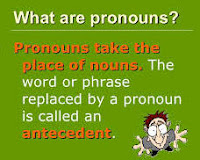Lesson Plan of Singular and Plural Pronouns English Grade 3
Lesson Plan of Singular and Plural Pronouns
English Grade 3
Students’ Learning Outcomes
·
Recognize that pronouns agree
with their nouns in gender and number
Information for Teachers
·
A pronoun must agree in
number with the noun it refers to.
Example : My brother broke his arm.
(brother-singular noun and ‘his’
singular pronoun)
·
Example : My students always
do their homework. (students-plural noun and their- plural pronoun)
·
While teaching the lesson,
the teacher should also consult the textbook where it is required.
Material / Resources
Board, chalks/markers,
selected text from the textbook.
Worm up Activity
·
Start the lesson by reviewing
the pronouns learnt previously.
·
Ask the students a few
sentences using possessive pronouns.
·
Now divide the students into
teams so that each row becomes one team (if there are 10 rows, 10 team are
formed)
·
Give each team a paper. Ask half
of the team (e.g. five teams) to write as many singular nouns as they can in
three minutes. Ask the other half of the teams to write as many plural nouns as
they can in three minutes.
·
Monitor all the teams to make
sure that all the students are engaged in the activity.
·
The team with the highest
number of noun (both singular and plural nouns), wins.
·
The members of winning teams
will receive colored starts on the written work.
·
Ask the class to clap for
winning team.
Development
Activity 1
·
Choose a few singular and
plural nouns from the students’ lists.
·
Now write a sentence on the
board containing a singular noun (from the students’ lists) and its pronoun
(singular). For example: The girl is eating her lunch.
·
Underline the noun ’girl’ and
ask the students if it is singular or plural. Then underline the word ‘her’ and
tell the students that it is used in place of ‘girl’.
·
Tell them that ‘her’ is also
singular noun, a singular pronoun is used.
·
Write more examples on the
board choosing singular nouns from the students’ lists. Involve the students in
each example.
·
Write a sentence on the board
containing a plural noun (from the students’ lists), for example : The friends
are playing in the garden.
·
Underline the noun. Friends:
and ask the students if it is singular or plural. Then underline the word ‘their’
and tell the students that it is used in place of friends. Tell them that ‘their’
is also plural. Tell the students that for a plural noun, a plural pronoun is
used. Write more examples on the board choosing plural nouns from the students’
lists. Involve the students in each example.
Activity 2
·
Ask the students to take out
their textbooks.
·
Read with the students the
piece of text that you must have selected already for the activity.
·
As the students read with
you, stop at sentences (where needed) and ask the students to recognize
singular or plural nouns and their pronouns.
Sum up / Conclusion
·
Review the lesson by asking
the students questions like: for a singular noun do we use a singular pronoun
or a plural pronoun? For a plural noun do we use a plural pronoun or a Singular
Pronouns? What are some plural Pronouns ?(Their, Our)
·
Ask the students to make two
separate columns in their notebooks. Ask them to write all the singular
pronouns in one column and all the plural pronouns in another column.
Assessment
·
Check the students’ ability to
recall the pronouns and produce singular and plural nouns learnt earlier in the
worm up activity by asking them about pronouns.
·
Assess how well the students
recognize that pronouns agree in number during the reading session.
·
Assess the students’
understanding of pronouns number agreement by giving them a short test.
·
Assess the ’students’ understanding
by checking the list of singular and plural pronouns they have made in their
notebook.
·
Involve the students in
solving the problems given in the exercise at the end of unit/chapter.
Follow up
·
Give the students five sentences (see sample
sentences at the end of the lesson plan). Ask the students to underline the
correct pronoun in each sentence by looking at the noun. Do this activity work
in the next class. Solve one sentence on the board. (write the sentences on the
board and ask the students to copy them).
Sample sentences – Follow up
Look at the underline noun in each sentence. Circle the
correct pronoun for each noun.
1.
My brother finished his /
their work.
2.
The boys lost his / their
books.
3.
Maria sleeps with
their / her doll.
4.
The students are doing
their / his homework.
5.
Children are eating
her / their breakfast.
6.
This girl is wearing
her / our blue dress.









Comments
Post a Comment